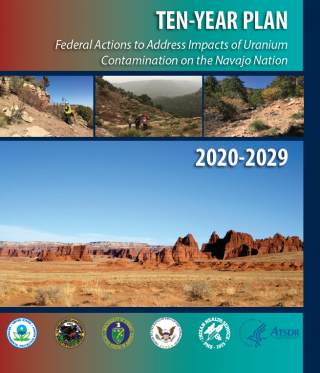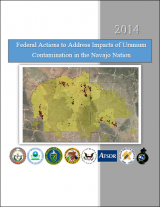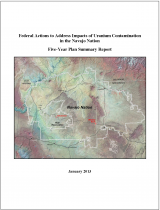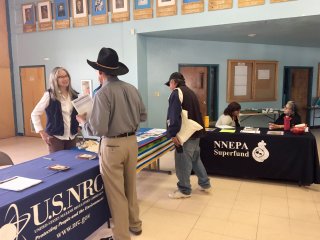
Free viewers and readers are available to access documents on our website. If you encounter issues with assistive technology, please contact us.
The Ten-Year Plan to Address Impacts of Uranium Contamination in the Navajo Nation - 2020-2029 (pdf) (5.3 MB, January 2021) continues the effort of the previous Five-Year Plans and identifies the next steps in addressing the human health and environmental risks associated with the legacy of uranium mining on the Navajo Nation.

The Ten-Year Plan was developed in cooperation with multiple federal partner agencies including Bureau of Indian Affairs, Department of Energy, Nuclear Regulatory Commission, Navajo Area Indian Health Service, and the Agency for Toxic Substances and Disease Registry to incorporates goals and milestones for achieving assessment and cleanup actions. The document contains discrete sections that includes objectives in the following areas:
The 2014–2018 Five Year Plan to Address Impacts of Uranium Contamination in the Navajo Nation (pdf) (1.32 MB, September 2014) builds on the work of the first 2008 Plan, making adjustments based on information gained during that period, and identifying the next steps in addressing the most significant risks to human health and the environment.
The effort focused on the most imminent risks to people living on the Navajo Nation. While the last five years represent a significant start in addressing the legacy of uranium mining, much work remains and the same federal agencies have collaborated to issue a second Five-Year Plan.
The second Five-Year Plan has the following major objectives:

The 2008–2012 Five Year Plan to Address Impacts of Uranium Contamination in the Navajo Nation (pdf) (639.14 KB, June 9, 2008) was the first coordinated effort by the federal government to address uranium contamination on the Navajo Nation. The Plan outlined a strategy for gaining a better understanding of the scope of the problem and for addressing the greatest risks first. As noted in the Navajo Uranium Report, 2013, this Plan was a significant start in addressing the legacy of uranium mining.
The Five-Year Plan was developed at the request of the U.S. House Committee on Oversight and Government Reform, and included participation of the following agencies: EPA, the Bureau of Indian Affairs (BIA), the Nuclear Regulatory Commission (NRC), the Department of Energy (DOE), the Indian Health Service (IHS), the Agency for Toxic Substances and Disease Registry and the Centers for Disease Control.
The following objectives were developed as part of the Five-Year Plan:

EPA Communications Lead: Damian Willson
willson.damian@epa.gov
(415) 972-3453
Community Outreach Network Liason: Shine Salt
shine.salt@lm.doe.gov
(970) 200-4607
In 2015, Federal and Navajo agencies created the Community Outreach Network to coordinate communication with residents about actions addressing uranium contamination on the Navajo Nation. The Network includes representatives from the following Federal Agencies: EPA, the Bureau of Indian Affairs, the Nuclear Regulatory Commission, the Department of Energy, the Indian Health Service, and the Agency for Toxic Substances and Disease Registry. The Network also includes the following Navajo Agencies: Navajo Nation Environmental Protection Agency, Navajo Abandoned Mine Lands/Uranium Mill Tailings Remedial Action Program, and the Navajo Nation Department of Health. The purpose of the Community Outreach Network is to coordinate outreach efforts to increase community understanding of the work agencies are doing to address uranium contamination on Navajo Nation. The Community Outreach Network plans workshops and meetings, creates educational material, and participates in local events to help the communities to stay involved and informed.

Shine Salt is the liaison of the Community Outreach Network. Her role is to work with communities to understand their concerns and to help support and organize the Network’s communication with communities. Please contact Shine (above) for more information about the Community Outreach Network.